Do you have a question about the Porter-Cable CPL6025 and is the answer not in the manual?
DANGER indicates an imminently hazardous situation which, if not avoided, will result in death or serious injury.
WARNING indicates a potentially hazardous situation which, if not avoided, could result in death or serious injury.
CAUTION indicates a potentially hazardous situation which, if not avoided, may result in minor or moderate injury.
CAUTION used without the safety alert symbol indicates a potentially hazardous situation which, if not avoided, may result in property damage.
Identifies hazards related to ignition of flammable vapors by compressor sparks and overheating due to blocked ventilation.
Details risks associated with air tank weakening from rust, modifications, or vibration, and tool/accessory over-pressurization.
Warns that exceeding pressure ratings of tools, spray guns, or inflatables can cause them to explode or fly apart.
Warns compressed air can cause tissue damage and propel debris at high speeds, causing injury or property damage.
Highlights that compressor air is not safe for breathing, and sprayed materials contain harmful vapors.
Explains that improper use of electricity can cause shock, and repairs by unqualified personnel can be fatal.
Details how moving parts like belts and pulleys can cause serious injury if contacted or if guards are removed.
Warns that touching hot metal parts like the compressor head or outlet tubes can cause serious burns.
Highlights the danger of a portable compressor falling from elevated positions, causing injury or death.
Covers risks of oil leaks causing fire, breathing hazards, and damage to vehicle surfaces during transport.
Details the function of key components like the drain valve, thermal protector, filter, pump, check valve, and safety valve.
Explains the function of the pressure switch, pressure release valve, tank gauge, outlet gauge, and regulator.
Lists the tools and parts required for the assembly process.
Step-by-step guide for attaching the wheels and rubber feet to the unit.
Instructions for attaching the unit's handle, including precautions for stability and lifting.
Advises on operating the compressor in a clean, dry, well-ventilated area, avoiding moisture and obstructions.
Explains the correct type of oil to use, cautions against overfilling, and details the importance of initial oil fill.
Details how to add compressor oil to the crankcase, including capacity and when to drain/refill.
Provides guidelines for using extension cords, emphasizing wire gauge, length, and grounding.
Refers to parts manual for voltage requirements and circuit protection, stressing correct fuse/breaker ratings.
Warns against plastic pipe, recommends metal pipe for air distribution, and guides on sizing and installation.
Explains grounding importance for reducing shock risk and avoiding adapters, with visual guide for 120V models.
Cautions against modifying the plug and ensuring proper grounding wire connection.
Steps for starting the compressor, including attaching hoses and setting the regulator.
Procedures for shutting down the compressor, including draining the tank and releasing pressure.
Outlines daily, every 40, 100, 160 hours, and yearly maintenance tasks.
Instructions for cleaning and replacing the air filter, emphasizing its importance for performance.
Details daily oil checks and recommended oil changes every 100 hours, including capacity and types.
Guide for inspecting, cleaning, or replacing the check valve annually or as needed.
Emphasizes daily testing of the safety valve for proper operation and replacement if faulty.
Warns about serious injury from moving parts and the need for guards during belt replacement.
Instructions for removing and installing the belt guard, including safety precautions.
Steps for replacing the drive belt, including motor tilt, centering, and tension adjustment.
Warns against adjusting or defeating the pressure switch and advises using the same rated switch for replacement.
Explains how to reset the motor's thermal overload protector by depressing the red button if the motor overheats.
Addresses issues with the pressure switch not shutting off the motor or contacts being welded.
Guide to tightening loose tube fittings and checking for leaks with soapy water solution.
Troubleshooting leaks from a malfunctioning or dirty check valve, advising removal and cleaning/replacement.
Addresses leaks from the pressure switch release valve due to malfunction, advising removal and replacement.
Instructs to replace the air tank if damaged, warning against modifying it due to explosion risk.
Advises operating safety valve manually; if it still leaks, it must be replaced.
Covers causes like loose pulley/flywheel, low oil, or carbon buildup, with corresponding corrections.
Addresses dirty air filters, excessive usage, or incorrect accessories as causes for restricted intake.
Covers causes from restricted intake to leaks, recommending filter cleaning, belt adjustment, or larger compressor.
Covers motor overload, malfunctioning capacitor/motor, pressure switch issues, loose connections, or tripped breakers.
Advise not to operate compressor in spray areas due to potential contamination of internal motor parts.
Addresses excessive belt wear due to loose or tight belts, loose pulleys, or pulley misalignment.
Identifies causes of squealing as loose belts, loose pulleys, or lack of oil, with corresponding corrections.
Explains that some pressure drop is normal, but excessive drop may require regulator adjustment.
Addresses continuous air leaks from the regulator knob due to dirty or damaged internal parts.
Describes filters, regulators, and lubricators for air line treatment, pressure control, and oil administration.
Details connectors, adapters, and fittings for joining air line components with NPT threads.
Discusses 3/8" I.D. hose for high CFM and 1/4" coil hose for lightweight, self-retracting applications.
Explains quick-connect bodies and plugs for easy attachment/separation, advising against mixing styles.
Outlines warranty periods for pumps and other parts, excluding damage from misuse, improper installation, or wear items.
Lists conditions not covered by warranty, such as cosmetic defects, expendable items, and consequential damages.
Provides instructions for obtaining warranty service, including contacting authorized centers and retaining proof of purchase.
DANGER indicates an imminently hazardous situation which, if not avoided, will result in death or serious injury.
WARNING indicates a potentially hazardous situation which, if not avoided, could result in death or serious injury.
CAUTION indicates a potentially hazardous situation which, if not avoided, may result in minor or moderate injury.
CAUTION used without the safety alert symbol indicates a potentially hazardous situation which, if not avoided, may result in property damage.
Identifies hazards related to ignition of flammable vapors by compressor sparks and overheating due to blocked ventilation.
Details risks associated with air tank weakening from rust, modifications, or vibration, and tool/accessory over-pressurization.
Warns that exceeding pressure ratings of tools, spray guns, or inflatables can cause them to explode or fly apart.
Warns compressed air can cause tissue damage and propel debris at high speeds, causing injury or property damage.
Highlights that compressor air is not safe for breathing, and sprayed materials contain harmful vapors.
Explains that improper use of electricity can cause shock, and repairs by unqualified personnel can be fatal.
Details how moving parts like belts and pulleys can cause serious injury if contacted or if guards are removed.
Warns that touching hot metal parts like the compressor head or outlet tubes can cause serious burns.
Highlights the danger of a portable compressor falling from elevated positions, causing injury or death.
Covers risks of oil leaks causing fire, breathing hazards, and damage to vehicle surfaces during transport.
Details the function of key components like the drain valve, thermal protector, filter, pump, check valve, and safety valve.
Explains the function of the pressure switch, pressure release valve, tank gauge, outlet gauge, and regulator.
Lists the tools and parts required for the assembly process.
Step-by-step guide for attaching the wheels and rubber feet to the unit.
Instructions for attaching the unit's handle, including precautions for stability and lifting.
Advises on operating the compressor in a clean, dry, well-ventilated area, avoiding moisture and obstructions.
Explains the correct type of oil to use, cautions against overfilling, and details the importance of initial oil fill.
Details how to add compressor oil to the crankcase, including capacity and when to drain/refill.
Provides guidelines for using extension cords, emphasizing wire gauge, length, and grounding.
Refers to parts manual for voltage requirements and circuit protection, stressing correct fuse/breaker ratings.
Warns against plastic pipe, recommends metal pipe for air distribution, and guides on sizing and installation.
Explains grounding importance for reducing shock risk and avoiding adapters, with visual guide for 120V models.
Cautions against modifying the plug and ensuring proper grounding wire connection.
Steps for starting the compressor, including attaching hoses and setting the regulator.
Procedures for shutting down the compressor, including draining the tank and releasing pressure.
Outlines daily, every 40, 100, 160 hours, and yearly maintenance tasks.
Instructions for cleaning and replacing the air filter, emphasizing its importance for performance.
Details daily oil checks and recommended oil changes every 100 hours, including capacity and types.
Guide for inspecting, cleaning, or replacing the check valve annually or as needed.
Emphasizes daily testing of the safety valve for proper operation and replacement if faulty.
Warns about serious injury from moving parts and the need for guards during belt replacement.
Instructions for removing and installing the belt guard, including safety precautions.
Steps for replacing the drive belt, including motor tilt, centering, and tension adjustment.
Warns against adjusting or defeating the pressure switch and advises using the same rated switch for replacement.
Explains how to reset the motor's thermal overload protector by depressing the red button if the motor overheats.
Addresses issues with the pressure switch not shutting off the motor or contacts being welded.
Guide to tightening loose tube fittings and checking for leaks with soapy water solution.
Troubleshooting leaks from a malfunctioning or dirty check valve, advising removal and cleaning/replacement.
Addresses leaks from the pressure switch release valve due to malfunction, advising removal and replacement.
Instructs to replace the air tank if damaged, warning against modifying it due to explosion risk.
Advises operating safety valve manually; if it still leaks, it must be replaced.
Covers causes like loose pulley/flywheel, low oil, or carbon buildup, with corresponding corrections.
Addresses dirty air filters, excessive usage, or incorrect accessories as causes for restricted intake.
Covers causes from restricted intake to leaks, recommending filter cleaning, belt adjustment, or larger compressor.
Covers motor overload, malfunctioning capacitor/motor, pressure switch issues, loose connections, or tripped breakers.
Advise not to operate compressor in spray areas due to potential contamination of internal motor parts.
Addresses excessive belt wear due to loose or tight belts, loose pulleys, or pulley misalignment.
Identifies causes of squealing as loose belts, loose pulleys, or lack of oil, with corresponding corrections.
Explains that some pressure drop is normal, but excessive drop may require regulator adjustment.
Addresses continuous air leaks from the regulator knob due to dirty or damaged internal parts.
Describes filters, regulators, and lubricators for air line treatment, pressure control, and oil administration.
Details connectors, adapters, and fittings for joining air line components with NPT threads.
Discusses 3/8" I.D. hose for high CFM and 1/4" coil hose for lightweight, self-retracting applications.
Explains quick-connect bodies and plugs for easy attachment/separation, advising against mixing styles.
Outlines warranty periods for pumps and other parts, excluding damage from misuse, improper installation, or wear items.
Lists conditions not covered by warranty, such as cosmetic defects, expendable items, and consequential damages.
Provides instructions for obtaining warranty service, including contacting authorized centers and retaining proof of purchase.
| Max Pressure | 150 PSI |
|---|---|
| Power Source | Electric |
| Voltage | 120V |
| Pump Type | Oil-Free |
| Motor | Induction |
| Amps | 15 Amps |
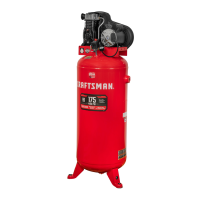
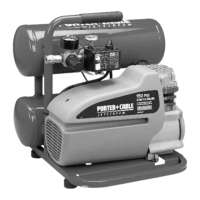
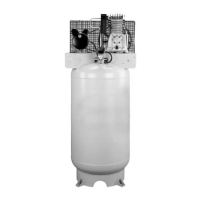
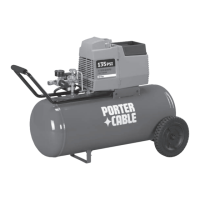
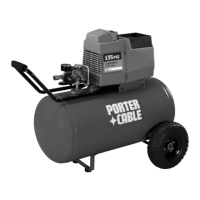
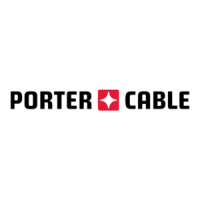
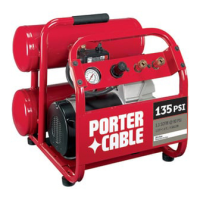
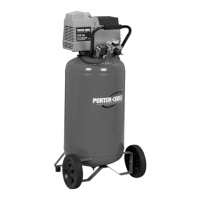
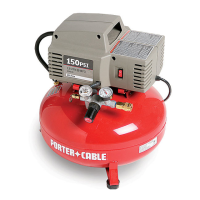
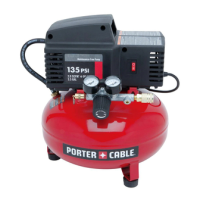

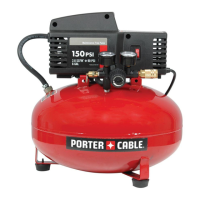
